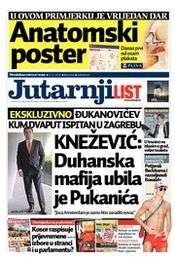Jutarnji list
|
Front page of the 17 October 2009 issue | |
| Type | Daily newspaper |
|---|---|
| Format | Berliner |
| Owner(s) | Hanza Media |
| Publisher | Hanza Media d.o.o. |
| Editor-in-chief | Goran Ogurlić[1] |
| Founded | 6 April 1998 |
| Political alignment |
Social democracy[2] Liberalism[3] |
| Language | Croatian |
| City | Zagreb |
| Country | Croatia |
| Circulation | 66,000 (October 2014) |
| ISSN | 1331-5692 |
| Website | Official website |
Jutarnji list (lit. "The Morning Paper") is an Croatian daily newspaper, founded and continuously published in Zagreb since April, 6, 1998, by Hanza Media. The newspaper is published in the berliner format and online. It's online edition jutarnji.hr is the second most visited news website in Croatia after Index.hr.[4]
According to the owner of Hanza Media Marijan Hanžeković, "Jutarnji list should be conceptually newspaper of liberal and social-democratic orientation, with emphasis on accuracy and relevance."
History and profile
Jutarni list was launched in April 1998,[5] becoming the first successful Croatian daily newspaper to appear since the 1950s.[6] It was named after a Zagreb daily that used to circulate before World War II. The newspaper is part of Europapress Holding media group.
Jutarnji is considered to be a more left-leaning liberal daily than Večernji list.
In 2003, Jutarnji list launched a comprehensive Sunday edition, Nedjeljni Jutarnji. On 19 February 2005, Jutarnji list published an exhaustive biography of Ante Gotovina.[7][8]
The paper quickly took the majority of Croatian media market and became one of the most read newspapers in that country. In the first five years it sold more than 214 million copies.[6] During the actual economic crisis the number of sold copies diminished from about 80,000 in 2007 to 52,763 in 2013.[6][9] The crisis hit in the same manner other daily newspapers in Croatia.[10] The circulation of Jutarnji list was 66,000 copies in October 2014.[11]
Controversies
In February 2008, Jutarnji list was involved in a scandal when it published an interview [12][13] with what was thought to be Croatian Prime Minister Ivo Sanader. The reporter contacted 23-year-old Viktor Zahtila by e-mail and SMS, who he assumed to be the prime minister.[14] Zahtila replied via email[15] and nowhere explicitly stated that he was Ivo Sanader. The reporter, Davor Butković, never checked to see if he was actually communicating with the PM.
References
- ↑ "Impressum" (in Croatian). Jutarnji list. 13 July 2013. Retrieved 13 July 2013.
- ↑ "Novi vlasnik o promjenama: Hanžeković želi od Jutarnjeg lista stvoriti medij koji je točan". Index.hr. Retrieved 3 January 2015.
- ↑ "Novi vlasnik o promjenama: Hanžeković želi od Jutarnjeg lista stvoriti medij koji je točan". Index.hr. Retrieved 3 January 2015.
- ↑ https://www.similarweb.com/top-websites/croatia
- ↑ Helena Popović et. al (29 October 2010). "The case of Croatia". Media policies and regulatory practices in a selected set of European countries, the EU and the Council of Europe (PDF). Athens: The Mediadem Consortium. Retrieved 2 January 2015.
- 1 2 3 Jutarnji list slavi peti Index.hr 3 April 2003. Retrieved 3 January 2015. (Croatian)
- ↑ A French translation of this investigation can be found in and titled "Courrier des Balkans".
- ↑ "Novinari Jutarnjeg lista ispričali se Thompsonu, a na portalu Jutarnjeg o tome šute - Portal Hrvatskoga kulturnog vijeća". Retrieved 2 January 2015.
- ↑ Novinar 4-7, 2013, Zagreb: HND, p. 30
- ↑ Novinar 4-7, 2013, Zagreb: HND, pp. 269-30
- ↑ Izvješće medijskih objava Archived December 15, 2014, at the Wayback Machine. Mediji. 10 October 2014. Retrieved 2 January 2014.
- ↑ "Jutarnji List apologises for PM fake interview". neurope.eu. Retrieved 2 January 2015.
- ↑ Zoran Radosavljevic (12 February 2008). "Croatian daily embarrassed by hoax PM interview". Reuters. Retrieved 27 February 2008.
- ↑ "Butkoviću intervju dao bivši novinar Nacionala i član Iskoraka". 11 February 2008. Retrieved 13 July 2013.
- ↑ Saša Vejnović (8 February 2008). "Butković nasjeo na 'virtualnog Sanadera'". Poslovni dnevnik. Retrieved 26 November 2014.
External links
- Official website (Croatian)
- Dean Sinovčić; Nina Ožegović (19 June 2007). "Novi val hrvatskih novina" [New wave of Croatian newspapers] (in Croatian). Nacional (weekly). Archived from the original on 10 July 2012. Retrieved 10 July 2012.

